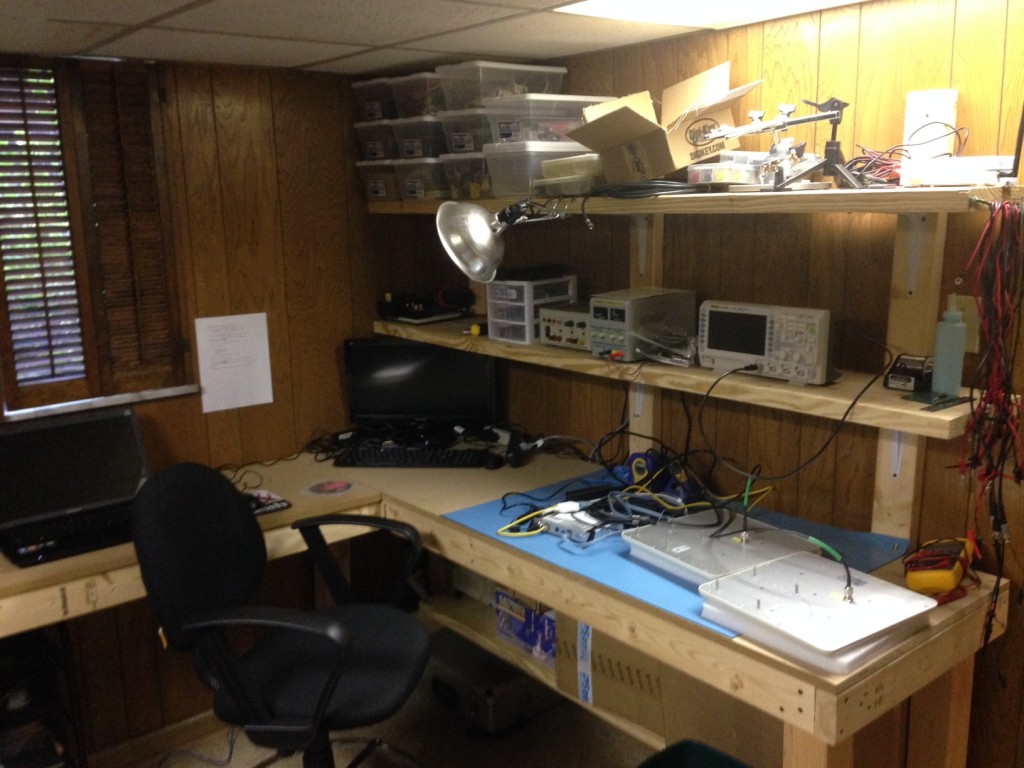The Workbench
This page has two parts; The things that I am working on, and the tools that I use (biased for electronics).
What I am Working on at Home
I am currently working on a several projects:
1. A new module for my workbench to let me read in GPS, analog, digital, pulse and encoder data; and then output it in a precise time-stamped format via serial. It will have a PPS output and an NTP server. If I am ambitions I will add CAN.
Update (3/31/2014): I sent out the PCB’s to be made. I was not ambitious enough to add CAN. Oh well.
Update (4/8/2014): I just found out about a similar project from Partially Stapled.
2. A fiber optic voice link. This has little practical application but I want to experiment with audio electronics and fiber optics. Both are areas that I have not played in much.
Update (1/31/2014): Pretty much done with this. I should revisit this again later.
3. A scanning platform so I can put different sensors on it for testing. I am thinking about being lazy and just put a string pot on a hinged board that I can read in with project #1.
4. A longer term project which I have not started yet, is a modular mobile platform that can be used for testing different components.
5. A better power logging/measuring device to integrate into a robot
6. A button (with an external trigger) to shutoff computers remotely.
7. USB Hub board to allow devices to be turned on and off. Also while controlling order of power on so Linux inits the /dev’s in the correct order.
8. FPGA based robot controller. Reads 1 SICK, 1 Hokuyo, 1 GPS NMEA, 2 Encoders. Controls analog controller, Elmo, and/or Copley motor controller. Ethernet enabled for all the above. Also outputs a PPS time signal and accepts a PPS time signal. This device can also be used as a time server.
My Tools
This is the fun section where I go through my workbench tools.
Tools you can grab
– Fluke 87V Multimeter – I really like this meter, it is probably the most useful bit of test equipment that I own. If it also had inductance and ESR I would absolutely love it.
– I also have tweezers for my multimeter similar to these that are great for testing SMD components.
– uCurrent – I don’t really use it that often but it is good for measuring really small currents (think nA) without placing a burden voltage on my circuits. It also works as a x100 voltage amplifier which is nice.
– Rigol DS1074Z-S Oscilloscope – Good digital scope w/ 4 inputs and some basic protocol analyzer functions built-in (for extra $$). Also has a built-in 2 port function generator. Useful since I rarely need it and it does not take up more room on my bench.
– BK Precision 2160A Oscilloscope – It is a pretty nice 60MHz scope. I like it since it is simple. However I do not use it often since I have my Rigol DSO.
– Hakko FX-888D Soldering iron – Good iron for the price. Has a good thermal capacity, can be a little confusing to use the controls at first. It is not as good as a professional quality iron but you can not beat the price. It also comes with a solder tip wire cleaner (like brass steel wool) that is great for cleaning your tip with (you can also get these separate). As with any soldering iron use a chisel tip (not a conical tip) as your default tip.
– Panavise circuit board holder – The accessories are almost useless but the holder is great and makes soldering jobs much easier. I also have a cheap helping hand, but I use the Panavise a lot more.
– A note on solder. I primarily use 63/37 LEAD solder. It melts nice, does not stay liquid for long, it has a single melting temperature instead of a wide range, gives good joints and it is easier to inspect. Since it has a single melting point I find that soldering wire together is easier than with other types of solder. The lead free stuff is awful! You need to get your board hotter (try doing that with large ground planes) and it is harder to tell if the joints are good. I also have a cheap solder holder so it site nicely on my workbench.
– For SMD work I only use curved pliers preferably with a cushioned handle. I am currently using these Excelta pliers, I like them but they are a bit expensive. I like the cushioned handle since I do all of my SMD work with them (one of these years I will start to use a reflow oven).
– For flux I tend to use a Kester flux pen. They are easy to use and clean. Why Kester? No good reason but it is a reputable company and I just do.
– I also really like the Xcelite cutters and pliers with the large black handles from Newark, Digikey, etc..
– Some other things I have but am not putting on this list because they are kits or cheap are several power supplies, a super cheap function generator, and some more multimeters.
Software
– Kicad – An opensource PCB layout tool
– Xilinx ISE – For all my FPGA work
– Atmel AVR Studio – For working with the AVR micros. I am still using AVR Studio 4 since I have some old designs.


Leave a Reply